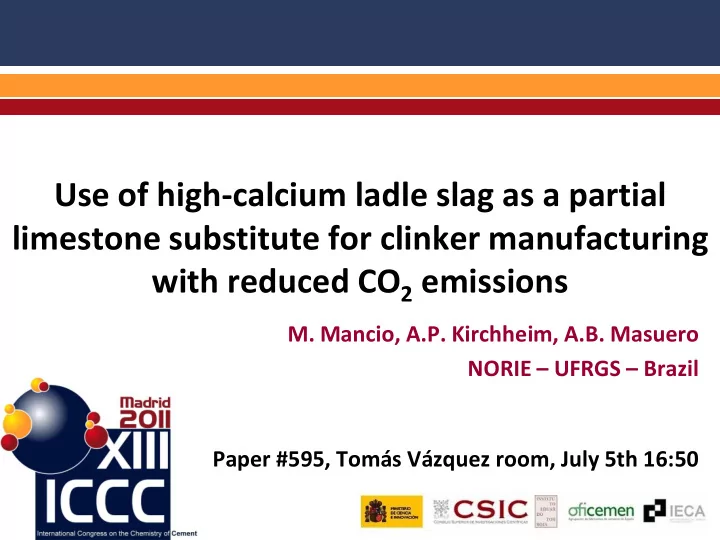

Use of high-calcium ladle slag as a partial limestone substitute for clinker manufacturing with reduced CO 2 emissions M. Mancio, A.P. Kirchheim, A.B. Masuero NORIE – UFRGS – Brazil Paper #595, Tomás Vázquez room, July 5th 16:50
Outline Introduction Environmental impact of clinker production Ladle slag Generation process, main characteristics Clinker production tests Partial replacement of limestone to reduce CO 2 Results and discussion Preview of industrial-scale tests Final comments
Introduction Today climate change is a major global concern • CO 2 concentration measured over the last 800,000 yrs Note: current emissions are higher than the “ higher emissions scenario” assumed in this projection Source: Karl, T.R. et al. June 2009. Available at: www.globalchange.gov/usimpacts
Introduction Cement production & CO 2 emissions: business as usual is not an option!
Introduction Typical rotary cement kiln equipped with preheater and precalciner. Mass proportion Lime
Annual reductions of 5 to 7 billion tons in CO 2 emissions are required in the next 10 years (in order to keep CO 2 concentration below 450 ppm) About 1 billion tons/year could be reduced by 2020 by replacing 50% of Portland cement by low-carbon alternatives. Source: Gigaton Throwdown Initiative (http://www.gigatonthrowdown.org)
Ladle slag Large part of CO 2 emissions in clinker production comes from the use of limestone Partially replacing CaCO 3 by alternative sources of CaO can be an effective way of reducing CO 2 emissions Industrial by-products rich in CaO One such alternative is ladle slag By-product from steel production in electric-arc furnaces Favorable chemical composition: 44% CaO, 35% SiO 2
Ladle slag generation
Ladle slag generation Ladle furnace Ladle slag being poured
Clinker production tests • Characterization of raw materials • Chemical compositions used for the calculations (XRF) Ladle slag Limestone Rice husk Fly ash meal ash CaO 43.7% 71.0% 1.8% 0.7% SiO 2 35.5% 14.2% 93.2% 70.0% Al 2 O 3 3.3% 2.9% 0.7% 14.6% MgO 6.6% 5.0% 0.4% 1.0% Fe 2 O 3 3.5% 4.7% 0.2% 6.5% • Evaluation of potential toxicity characteristics of Ladle slag (TCLP tests) non-hazardous waste • Proportioning of raw materials • Based on the desired clinker composition and specified lime saturation factor (LSF), silica ratio (SR) and alumina ratio (AR) parameters
Clinker production tests Mixtures used for the laboratory clinker production experiments Mix 1 Mix 2 Mix 3 Mix 4 Limestone-based meal 90% 83% 83% 65% Ladle slag 0% 9% 9% 35% Rice husk ash 10% 8% – – Fly ash – – 8% – Total 100% 100% 100% 100% Limestone replacement 0% 7,8% 7,8% 27,8% CO 2 reduction 0% 5,9% 5,9% 23,1%
Clinker production in the lab
Results Chemical composition of lab clinkers X-ray fluorescence tests Control Clinker 1 Clinker 2 Clinker 3 Clinker 4 CaO 60% to 62% 61,4% 60,1% 60,2% 58,0% SiO 2 20% to 21% 23,3% 23,6% 22,1% 22,7% Al 2 O 3 4,0% 4,5% 4,0% 5,3% 4,8% MgO 7,3% 4,9% 5,6% 5,1% 6,1% Fe 2 O 3 3,0% 5,0% 5,1% 5,4% 5,2% MnO – 0,3% 0,7% 0,6% 1,9% LSF 0,92 to 0,99 0,83 0,81 0,84 0,80 LSF (II) 1,08 to 1,16 0,93 0,92 0,95 0,93 SR 2,92 to 3,07 2,44 2,59 2,05 2,25 AR 1,33 0,90 0,79 0,98 0,93
Results Mineralogical composition XRDs (qualitative analysis) form_1a Clinker 1 Raw mix = 83% 400 RHA = 10% Main phases: • C 2 S • C 3 S 100 • C 3 A • C 4 AF • MgO 0 10 20 30 40 50 60 70 Position [°2Theta]
Results Mineralogical composition Quantification of phases formed MgSO4 - 5% EM ÁGUA - 10s SEM ATAQUE QUÍMICO Analyses in optical microscope w/ pixel counting • Quantitative analysis HNO 3 1% EM ÁLCOOL + 1/3 ÁGUA - 1s HNO 3 0,1% EM ÁLCOOL - 10s • Provides more + NH 4 Cl 0,1% EM ÁGUA - 10s reliable data than Bogue estimates Figure source: M.A. Cincotto
Results Main phases formed Control Clinker 1 Clinker 2 Clinker 3 Clinker 4 (Bogue) Belite (C 2 S) 75,6% 83,1% 75,7% 75,7% 16,5% Alite (C 3 S) 9,3% 3,9% 7,3% 3,1% 69,0% C 3 A 1,6% 0,8% 2,4% 2,7% 5,1% C 4 AF 9,1% 7,8% 9,8% 13,5% 9,0% CaO free 1,0% 0,6% 0,1% 0,7% 1% to 5% Periclase 3,4% 3,8% 4,7% 4,2% 7,3% C 3 S + C 2 S 85,7% 87,0% 83,0% 78,8% 85,5% C 3 A + C 4 AF 9,8% 8,7% 12,2% 16,3% 14,1% CaO MgO C4AF 1.0% 3.4% C3A 9.1% 1.6% Alita 9.3% Belita 75.6%
Industrial-scale tests Partnership with local steel and cement producers
Industrial-scale tests Quality control one day before, during and after the industrial-scale tests 80 70 60 50 C3S 40 C2S 30 C3A C4AF 20 10 0
Final comments Ladle slag is a byproduct from steel production in electric mills that is routinely treated as waste and disposed off in landfills It presents high levels of CaO and SiO 2 , in addition to low Fe content, a very favorable composition for incorporation into clinker manufacturing This study evaluated, for the first time, the technical and environmental feasibility of using this slag for clinker production The material is classified as a non-hazardous waste , and can be safely used as a raw material in cement production
Final comments It was possible to produce lab-made experimental clinkers with Ladle slag as a partial limestone substitute, thus enabling considerable reductions in CO 2 emissions related to the calcination reaction The chemical composition of the produced clinkers closely resembled the reference industrial clinker, and the total content of calcium silicates (C 2 S + C 3 S) formed was satisfactory However, the relative quantity of C 2 S was higher than expected, which is likely due to the elevated silica content, a short sintering time, and a fast cooling rate in the lab
Recommend
More recommend